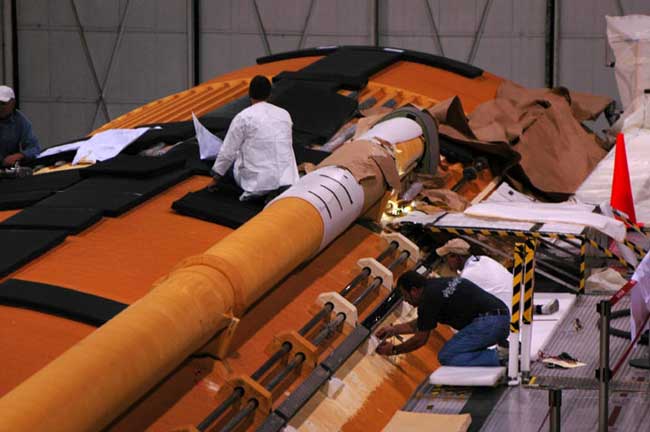ET: A New Generation

Near the northern limit of NewOrleans, situated in the lowlands of the IntracoastalCanal between Lake Pontchartrain and Lake Borgne, is the NASA MichoudAssembly Facility. Here is where the largest single component of the SpaceTransportation System, more commonly known as the Space Shuttle, takes shape:the External Tank.
The black-and-white winged beauty ofthe space shuttle orbiter is recognizable to nearly everyone.
This is where the crew of astronautsrides the fury hundreds of miles into space to perform their duties:constructing a space station, servicing a telescope that peers at thebeginnings of the universe, or performs experiments that will hopefully furtherour goals of permanent human settlements off our home planet.
To get the orbiter into space toaccomplish these tasks requires the help of two Solid Rocket Boosters (SRBs) that look like tall, white candlesticks, and the153.8 foot tall, giant orange External Tank (ET). Without this fuel tank,nothing gets off the pad and nothing achieves orbit, since this is thereservoir for the Space Shuttle Main Engines (SSMEs),three of which reside at the rear of the orbiter. When discussions of the ETcome up, many often refer to it as a huge soda can. After all, the basicstructure is thin aluminum covered by a layer of its signature orangeinsulating foam. This keeps the fuels in its liquid oxygen (LOX) and liquidhydrogen (LH2) tanks chilled. There are no fancy engines attached to the tankand no crew ride aboard it.
The ET-fed SSMEsfire in concert with the twin SRBs to lift the stackoff the launch pad. Two minutes later, the solids are finished and fall away,but the ET keeps fuel flowing to the shuttle engines for another six-and-a-halfminutes to complete the ride to orbit.
Once the fuels in the ET aredepleted, it is jettisoned to fall back into the ocean, the only majorcomponent of the shuttle that is not recycled. During this eight-and-a-halfminutes, over half a million gallons of fuel carried by the ET, or about 62,000gallons a minute, is transferred to the SSMEs toburn-over a thousand gallons each second are converted to thrust to propel theSpace Shuttle and its payload to orbit.
I had the pleasure to visit Michoud (pronounced me-shu)recently under the guidance of Harry Wadsworth of Lockheed Martin, the primarycontractor for the ET. My purpose was to understand and record the assembly ofthe External Tank; however, it became much more than that as I learned of thedevastation and hardship that these people have overcome from the onslaught ofHurricane Katrina last August.
Breaking space news, the latest updates on rocket launches, skywatching events and more!
Originally built to make woodencargo planes in World War 2, the Michoud factory cameon line too late in the war. Only two planes ever left the assembly line ofthis 832-acre facility, 43 acres of which are under a single roof-theproduction factory. NASA took over the area in 1961 to create the facility tobuild the first stage of the Saturn V booster. As part of the Space Shuttleprogram, Michoud was converted to External Tankproduction in the mid-1970s.
Following Katrina, the facility wasforced to shut down all work, threatening future shuttle missions. Although thelevees held around the facility, they suffered extensive flooding as a 20-footwall of water topped the levees in two places and 13 inches of rain pounded Michoud, extensively damaging buildings and tearing offroofs. As Harry explained, "We kept our pumps running the entire storm viaa huge generator, so water was constantly being pumped out. That saved ourfactory. Had the factory flooded we could have lost the Space Shuttle program.Credit goes to our ride-out crew, the 38 men and women who stayed behind tocare for the facility."
The entire area was near the eye ofthe storm, and 47 percent of the 2,000 person Michoudworkforce found themselves unable to return home. Nonetheless, even with theirown personal losses, the Lockheed Martin and NASA employees returned quickly toclean up the damage and re-open the plant within only three weeks, all thiswhile also serving to aid the community as a whole in their recovery effort.Even nearly a year later, there is much damage still evident. Levees are beingrebuilt and buildings get patched in anticipation of the start of a new summerhurricane season. The dedication of the workers to bring our space program backto full throttle is amazing to witness.
The External Tank came to prominentfocus after the loss of Columbia on February 1, 2003. Pieces of the foaminsulation dislodged during launch ascent and struck the leading edge ofColumbia's left wing, leaving damage that caused the wing to fail 16 dayslater, during reentry. The insulation that caused the fatal damage was at thebase of the bipod area of the ET, which is the forward attach point of theshuttle orbiter.
In response to the Columbia AccidentInvestigation Board, the ET foam installation procedures have been greatlymodified. In addition, after the first post-Columbia test flight of Discoveryon mission STS-114 last summer proved, the fix was not complete. Engineers wentback to their computers and wind tunnels. In the end, it has been decided thatone of the safest ways to continue flying is to actually remove some of theareas of foam causing the most difficulty.
One such area is called theProtuberance Airloads (PAL) ramps. Original testingshowed the PAL ramp near the top of the liquid hydrogen tank to be acceptablefor flight, but a large piece of this ramp came off late in the STS-114 ascent,nearly missing Discovery's underbelly heat tiles.
This PAL ramp has now been removedfrom the ET completely, and wind tunnel testing confirms the aerodynamics ofthe shuttle stack should not be significantly affected. At this point, the onlything left to do is fly the mission and see where we stand on the ET foamissue, and if the remainder of the Space Shuttle missions will fly as plannedbetween now and retirement in 2010.
You might believe that since the ETis similar to a huge soda can, it would be simple and quick to manufacture. Inactuality, each External Tank takes 20 months to construct.
The 97-foot long LH2
tank and 55-foot long LOX tank are matedto an intertank assembly, fuel feed lines areinstalled, and a thermal protection coating made of a spray-on foam insulationis added. Ranging from one to two inches in thickness, this foam adds 4,100pounds to the gross weight of the ET, and it also serves to hold the tanktogether as reentry breakup starts to occur to create a smaller footprint whereits pieces fall into the ocean.
I found it extremely interesting towatch people at work on the tank. In some cases their jobs resembled more asculptor rather than an aerospace technician. I saw the foam areas beingmeticulously worked with carving tools to create exactly the correct shape.
At one point I saw a
couple men, carefully walking on blackpads to protect the tank foam, vacuuming the insulation to remove particulatematter that could shed. The head of the vacuum wand was similar to what youwould use in your home to clean upholstery.
Spaceflightis an art form, and the people at Michoud aredefinitely artists. Their work reflects their dedication to returningspaceflight to a safe and reliable proposition, and is vital to our continuedpresence in space. Major elements of a new generation of human launch vehicleswill be derived from their work on the External Tank. Their personal dedicationto our future in the face of adversity from the extreme forces of nature, underwhich the Gulf Coast must live, cannot be equaled.
